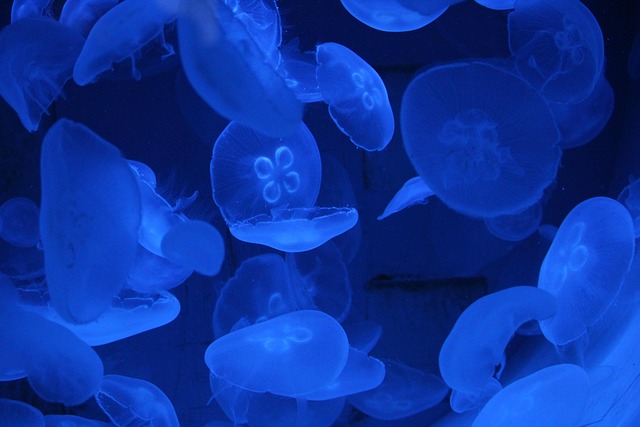Creating educational aquarium exhibits with multi-species habitats offers a dynamic learning experience. By showcasing natural ecosystems and their complex dynamics, these aquariums spark curiosity about ocean conservation and biodiversity. Through thoughtful species selection and interactions, exhibits maintain water quality and present vibrant displays. Design elements like realistic landscapes, compatible species, and interactive signage enhance educational value. Maintaining ecological balance ensures healthy habitats while inspiring public appreciation for marine diversity.
Explore the power of multi-species habitats in creating realistic ocean environments for educational aquarium exhibits. This article delves into the benefits, species selection, design considerations, and visitor engagement strategies that make these ecosystems a game-changer for aquariums. Discover how fostering complex interactions among diverse marine life enhances both conservation awareness and visitor experiences. Uncover the secrets to crafting captivating, ecologically accurate displays that inspire and educate.
Understanding Multi-species Habitats: Benefits for Educational Aquarium Exhibits
Creating multi-species habitats in educational aquarium exhibits offers a myriad of benefits that enhance both the ecological understanding and visitor experience. By replicating natural ecosystems, these displays showcase the intricate relationships between marine life—from predators to prey, symbiotic partners, and decomposers—all coexisting within a balanced ecosystem. This approach not only inspires curiosity about ocean conservation but also provides valuable insights into biodiversity and ecology.
Moreover, multi-species habitats facilitate interactive learning opportunities. Visitors can observe predator-prey dynamics, the role of scavengers, and the complex web of dependencies that sustain marine ecosystems. Such immersive experiences foster a deeper connection with the ocean’s complexities, encouraging visitors to become advocates for protecting these diverse habitats and their inhabitants.
Creating Realistic Ocean Environments: Species Selection and Interactions
Creating realistic ocean environments in educational aquarium exhibits requires careful consideration of species selection and their interactions. Each species has unique ecological roles, behaviors, and requirements that must be respected to ensure a balanced and functional ecosystem within the aquarium. For instance, selecting both filter feeders like sea anemones and predators such as tangs can help maintain water quality by controlling plankton populations.
Furthermore, understanding species interactions—predator-prey dynamics, territorial behavior, and mutualistic relationships—is crucial for creating a vibrant and natural display. Careful planning ensures that species co-exist harmoniously, providing visitors with an educational experience that mirrors the complexities of real ocean environments. This approach not only enhances the aesthetic appeal but also fosters a deeper understanding of marine biodiversity and conservation.
Design Considerations for Effective Multi-species Aquarium Displays
When designing multi-species aquarium displays, creating a realistic ocean environment requires careful consideration. One key aspect is mimicking the natural habitats of each species, providing them with suitable hiding spots, territories, and resources. This involves incorporating diverse aquatic landscapes, from coral reefs to kelp forests, allowing species to interact authentically. Educational signage and interactive elements can enhance visitor engagement while conveying the importance of biodiversity and habitat preservation.
Additionally, maintaining ecological balance within the exhibit is crucial. Careful selection of species compatibility ensures peaceful coexistence without disrupting the overall ecosystem. Controlled water circulation, filtration, and monitoring systems are essential tools for keeping the environment healthy. These design considerations not only foster a visually stunning display but also offer valuable educational aquarium exhibits that promote public appreciation and understanding of ocean biodiversity.
Enhancing Visitor Engagement: Educational Opportunities in Multi-species Habitats
Multi-species habitats in educational aquariums offer a unique and engaging experience for visitors, fostering a deeper connection with the ocean’s diversity. By showcasing various marine species interacting naturally, these exhibits spark curiosity and interest, especially among families and young learners. Educational aquarium displays provide an opportunity to educate the public about complex ecological relationships and the importance of biodiversity.
Through interactive displays and informative signage, visitors can gain insights into the specialized roles each species plays in maintaining a balanced ocean ecosystem. This hands-on learning approach encourages active participation, making it more memorable. The dynamic nature of multi-species habitats allows for regular updates on research findings, ensuring that aquarium exhibits remain relevant and captivating, thus enhancing visitor engagement and promoting environmental stewardship.
Multi-species habitats offer a transformative approach to educational aquarium exhibits, creating realistic ocean environments that captivate visitors and foster a deeper understanding of marine ecosystems. By carefully selecting species with complementary behaviors and ecological roles, aquariums can design displays that not only entertain but also educate. These habitats provide unique opportunities for engagement, allowing visitors to explore the intricate web of interactions within an ocean ecosystem. Through thoughtful design considerations, aquariums can effectively showcase the beauty and complexity of our marine world, leaving a lasting impression on all who experience these dynamic, multi-species habitats.
